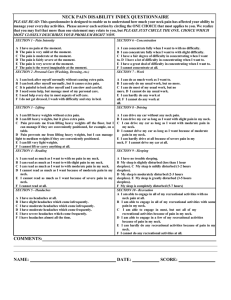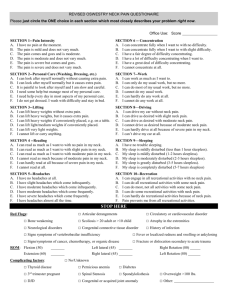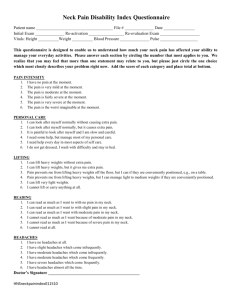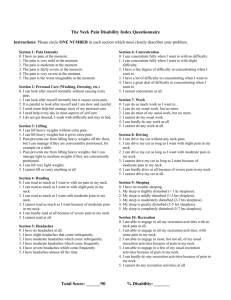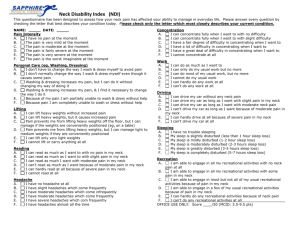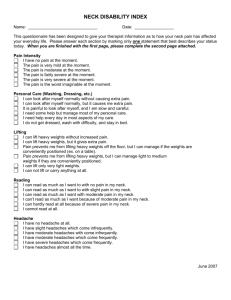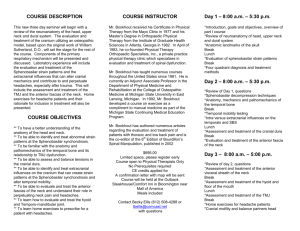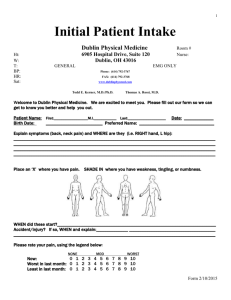NECK PAIN DISABILITY INDEX QUESTIONNAIRE
advertisement
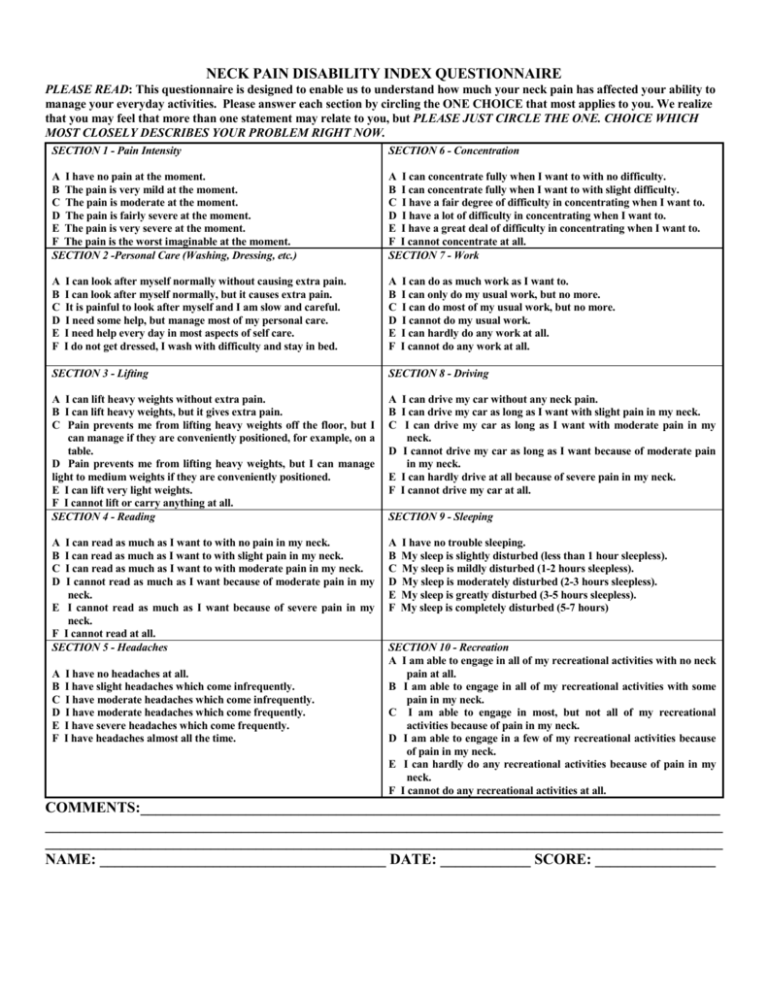
NECK PAIN DISABILITY INDEX QUESTIONNAIRE PLEASE READ: This questionnaire is designed to enable us to understand how much your neck pain has affected your ability to manage your everyday activities. Please answer each section by circling the ONE CHOICE that most applies to you. We realize that you may feel that more than one statement may relate to you, but PLEASE JUST CIRCLE THE ONE. CHOICE WHICH MOST CLOSELY DESCRIBES YOUR PROBLEM RIGHT NOW. SECTION 1 - Pain Intensity SECTION 6 - Concentration A I have no pain at the moment. B The pain is very mild at the moment. C The pain is moderate at the moment. D The pain is fairly severe at the moment. E The pain is very severe at the moment. F The pain is the worst imaginable at the moment. SECTION 2 -Personal Care (Washing, Dressing, etc.) A I can concentrate fully when I want to with no difficulty. B I can concentrate fully when I want to with slight difficulty. C I have a fair degree of difficulty in concentrating when I want to. D I have a lot of difficulty in concentrating when I want to. E I have a great deal of difficulty in concentrating when I want to. F I cannot concentrate at all. SECTION 7 - Work A B C D E F A B C D E F I can look after myself normally without causing extra pain. I can look after myself normally, but it causes extra pain. It is painful to look after myself and I am slow and careful. I need some help, but manage most of my personal care. I need help every day in most aspects of self care. I do not get dressed, I wash with difficulty and stay in bed. I can do as much work as I want to. I can only do my usual work, but no more. I can do most of my usual work, but no more. I cannot do my usual work. I can hardly do any work at all. I cannot do any work at all. SECTION 3 - Lifting SECTION 8 - Driving A I can lift heavy weights without extra pain. B I can lift heavy weights, but it gives extra pain. C Pain prevents me from lifting heavy weights off the floor, but I can manage if they are conveniently positioned, for example, on a table. D Pain prevents me from lifting heavy weights, but I can manage light to medium weights if they are conveniently positioned. E I can lift very light weights. F I cannot lift or carry anything at all. SECTION 4 - Reading A I can drive my car without any neck pain. B I can drive my car as long as I want with slight pain in my neck. C I can drive my car as long as I want with moderate pain in my neck. D I cannot drive my car as long as I want because of moderate pain in my neck. E I can hardly drive at all because of severe pain in my neck. F I cannot drive my car at all. A B C D A B C D E F I can read as much as I want to with no pain in my neck. I can read as much as I want to with slight pain in my neck. I can read as much as I want to with moderate pain in my neck. I cannot read as much as I want because of moderate pain in my neck. E I cannot read as much as I want because of severe pain in my neck. F I cannot read at all. SECTION 5 - Headaches A B C D E F I have no headaches at all. I have slight headaches which come infrequently. I have moderate headaches which come infrequently. I have moderate headaches which come frequently. I have severe headaches which come frequently. I have headaches almost all the time. SECTION 9 - Sleeping I have no trouble sleeping. My sleep is slightly disturbed (less than 1 hour sleepless). My sleep is mildly disturbed (1-2 hours sleepless). My sleep is moderately disturbed (2-3 hours sleepless). My sleep is greatly disturbed (3-5 hours sleepless). My sleep is completely disturbed (5-7 hours) SECTION 10 - Recreation A I am able to engage in all of my recreational activities with no neck pain at all. B I am able to engage in all of my recreational activities with some pain in my neck. C I am able to engage in most, but not all of my recreational activities because of pain in my neck. D I am able to engage in a few of my recreational activities because of pain in my neck. E I can hardly do any recreational activities because of pain in my neck. F I cannot do any recreational activities at all. COMMENTS:_____________________________________________________________________________ __________________________________________________________________________________________ __________________________________________________________________________________________ NAME: ______________________________________ DATE: ____________ SCORE: ________________ SCORING TECHNIQUE FOR THE OSWESTRY LOW BACK DISABILITY QUESTIONNAIRE AND NECK DISABILITY INDEX 1. Each of the 10 sections is scored separately (0 to 5 points each) and then added up (max. total = 50). EXAMPLE: Section 1. Pain Intensity Point Value A. ______ I have no pain at the moment 0 B. ______ The pain is very mild at the moment 1 C. ______ The pain is moderate at the moment 2 D. ______ The pain is fairly severe at the moment 3 E. ______ The pain is very severe at the moment 4 F. ______ The pain is the worst imaginable 5 2. If all 10 sections are completed, simply double the patients score. 3. If a section is omitted, divide the patient’s total score by the number of sections completed times 5. FORMULA: PATIENT’S SCORE # OF SECTIONS COMPLETED X 5 X 100 = ________ % DISABILITY EXAMPLE: If 9 of 10 sections are completed, divide the patient’s score by 9 X 5 = 45; if…….. Patient’s Score: 22 Number of sections completed: 9 (9 X 5 = 45) 22/45 X 100 = 48 % disability 4. Interpretation of disability scores (from original article): SCORE INTERPRETATION OF THE OSWESTRY LBP DISABILITY QUESTIONNAIRE 0-20% Can cope w/ most ADL’s. Usually no treatment needed, apart from advice on lifting, Minimal sitting, posture, physical fitness and diet. In this group, some patients have particular Disability difficulty with sitting and this may be important if their occupation is sedentary (typist, driver, etc.) 20-40% This group experiences more pain and problems with sitting, lifting and standing. Travel Moderate and social life are more difficult and they may well be off work. Personal care, sexual Disability activity and sleeping are not grossly affected, and the back condition can usually be managed by conservative means. 40-60% Severe Disability Pain remains the main problem in this group of patients by travel, personal care, social life, sexual activity and sleep are also affected. These patients require detailed investigation. 60-80% Crippled Back pain impinges on all aspects of these patients’ lives both at home and at work. Positive intervention is required. 80-100% These patients are either bed-bound or exaggerating their symptoms. This can be evaluated by careful observation of the patient during the medical examination. Reference: Fairbanks CT, Couper C, Davies JB, O’Brien JP. The Oswestry low back pain disability questionnaire. Physio Ther 1980;66:271-273.
